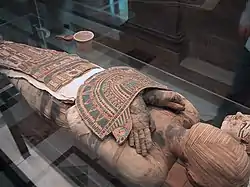木乃伊
Chinese
| phonetic | ||||
|---|---|---|---|---|
| simp. and trad. (木乃伊) | 木 | 乃 | 伊 | |
Etymology
From an unidentified western language, presumably from some language in the Islamosphere. Compare Persian مومیایی (mōmiyāyī, mūmiyāyī, “mummy; shilajit”) and مومنایی (mūmināyī, “shilajit”). A Western traveller (Engelbert Kaempfer) also encountered the latter in Persia in the 1680s.[1] Earliest attestation was in Ming Dynasty, see the following quote:
- 回回田地有年七八十歲老人,自願捨身濟眾者,絕不飲食,惟澡身啖蜜,經月,便溺皆蜜。既死,國人殮以石棺,仍滿用蜜浸,鐫志歲月於棺蓋,瘞之。俟百年啟封,則蜜劑也……俗曰蜜人,番言木乃伊。 [Classical Chinese, trad.]
- From: 明‧陶宗儀《輟耕錄‧木乃伊》 (Tao Zongyi (Ming Dynasty), "Chuogenglu - Record after retiring from plowing", Chapter "Mummies")
- Huíhuí tiándì yǒu nián qī bāshí suì lǎorén, zìyuàn shěshēn jìzhòng zhě, jué bù yǐnshí, wéi zǎo shēn dàn mì, jīng yuè, biàn nì jiē mì. Jì sǐ, guórén liàn yǐ shíguān, réng mǎn yòng mì jìn, juānzhì suìyuè yú guāngài, yì zhī. Sì bǎi nián qǐfēng, zé mì jì yě...... Sú yuē mìrén, fān yán mùnǎiyī. [Pinyin]
- There were men 70 to 80 years of age in Arabia (?) willing to give their bodies to save others. They never ate or drink, only bathed and partook of honey. After a month, their excrement (urine and faeces) consisted of honey only. After they died, their fellow men would place them in stone coffins full of honey in which they macerated. The year and month of deaths were engraved on the coffins and the coffins were buried. After a hundred years the coffins were reopened - a confection of honey had formed. Colloquially people called these "mellified men", in their native tongue "munaiyi".
回回田地有年七八十岁老人,自愿舍身济众者,绝不饮食,惟澡身啖蜜,经月,便溺皆蜜。既死,国人殓以石棺,仍满用蜜浸,镌志岁月于棺盖,瘗之。俟百年启封,则蜜剂也……俗曰蜜人,番言木乃伊。 [Classical Chinese, simp.]
See also "Mellified men" on Wikipedia. Other transliterations include:
- 木蜜納亦/木蜜纳亦 (mùmìnàyì, “mummy”), attested in Huihui Yaofang (Islamic Formularies, ca. 14th century);
- 木蜜亞依/木蜜亚依 (mùmìyàyī), attested in Mingjing Cidian (明淨詞典);
- 木蜜亞/木蜜亚 (mùmìyà) (from Uyghur),
all of which might have referred to Shilajit (地蠟/地蜡 (dìlà)) originally.
Pronunciation
Noun
木乃伊
- mummy (embalmed corpse)
References
- Sir William Ouseley (1821), Travels in Various Countries of the East; More Particularly Persia. Rodley and Martin, Vol. 2, p. 478 Google Books
Japanese

| Kanji in this term | ||
|---|---|---|
| 木 | 乃 | 伊 |
| みいら | ||
| Grade: 1 | Jinmeiyō | Jinmeiyō |
| jukujikun | ||
Alternative forms
- ミイラ (a more common modern spelling)
Etymology
From Portuguese mirra (“myrrh, skeleton, mummy”)[1][2][3][4] or Dutch mirre (“myrrh”).[1]
The kanji spelling 木乃伊 is an example of jukujikun. This spelling was borrowed from Chinese 木乃伊 (mùnǎiyī, “mummy”)[1][4][2][5]. Some Japanese sources[1][4][2][5] suggest that the Chinese term was a transliteration of Dutch mummie (with some stated concern that this derivation is doubtful[5]), but it appears that the Dutch and Chinese terms are not directly related, though they may be cognates. See the Chinese entry for more.
Pronunciation
- (Irregular reading)
- (Tokyo) みいら [míꜜìrà] (Atamadaka – [1])[6][7][4]
- IPA(key): [mʲiːɾa̠]
Noun
木乃伊 • (mīra)
- a mummy, deliberately preserved, such as those found in the ancient tombs of Egypt or China
- a human or animal corpse mummified naturally, such as in a peat bog or desert
Derived terms
- 木乃伊取りが木乃伊になる (mīra tori ga mīra ni naru)
References
- 1988, 国語大辞典(新装版) (Kokugo Dai Jiten, Revised Edition) (in Japanese), Tōkyō: Shogakukan
- 1995, 大辞泉 (Daijisen) (in Japanese), Tōkyō: Shogakukan, →ISBN
- 1998, 広辞苑 (Kōjien), Fifth Edition (in Japanese), Tōkyō: Iwanami Shoten, →ISBN
- 2006, 大辞林 (Daijirin), Third Edition (in Japanese), Tōkyō: Sanseidō, →ISBN
- 1997, 新明解国語辞典 (Shin Meikai Kokugo Jiten), Fifth Edition (in Japanese), Tōkyō: Sanseidō, →ISBN
- 1997, 新明解国語辞典 (Shin Meikai Kokugo Jiten), Fifth Edition (in Japanese), Tōkyō: Sanseidō, →ISBN
- 1998, NHK日本語発音アクセント辞典 (NHK Japanese Pronunciation Accent Dictionary) (in Japanese), Tōkyō: NHK, →ISBN